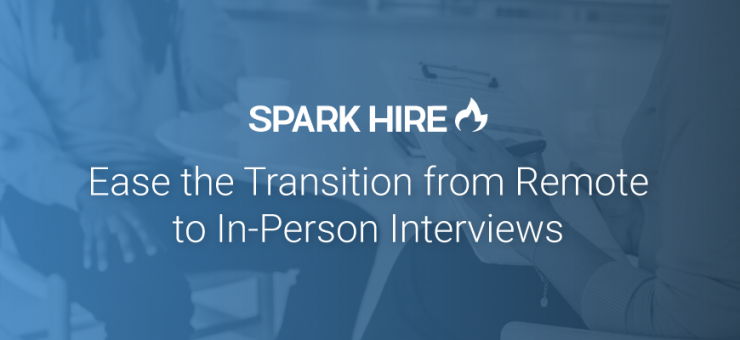Remote interviews, before the COVID-19 pandemic, were most commonly used for long-distance candidates or a quick video screening before the first (of many) in-person interviews. That’s all changed now.
Video technology became the saving-grace for HR and hiring teams when companies were bumped into full virtual hiring mode by mid-2020. Both one-way and live video interviews enabled companies to maintain growth and evolve their teams for better agility and resilience during the pandemic. Due to their success, many hiring teams are not planning to return to their traditional hiring practices.
While video interviews offer an accurate and engaging way to screen talent, it can be jarring to transition between making the first impression from the comfort of your home to nervously shaking hands — for both candidates and hiring managers. To ensure video interviews remain a valuable and efficient step in your hiring process, check out these tips to ease the transition from remote to in-person interviews:
Clearly communicate expectations
Not long ago, candidates could expect to experience 3-5 in-person interviews before a hiring decision was made. This was true for almost any role in any industry. Since early 2020, however, many candidates have experienced few, if any, in-person interviews. In fact, many candidates have moved directly from virtual hiring processes into remote roles.
The world has reopened, however, expectations and processes have changed for good.
Along with this shift to a hybrid workforce, numerous hiring professionals recognize the benefits of eliminating many of the early in-person interviews. With remote interviews replacing most of the initial stages of the hiring process, candidates face new challenges.
For example, expectations could differ between video interview presentations and how the candidate should dress or prepare for final in-person interviews. And this could vary depending on the role or the hiring manager conducting the interview.
To prevent confusion, interview expectations should be decided as a team and everyone needs easy access to review what is expected of candidates. These expectations should be clearly shared and apparent for candidates as well.
This information can be made clear through a simple checklist provided when candidates are invited to interview and reinforced through branding on the website and social media. Also, consider how you can provide candidates an inside look at your workforce. Images and videos help them further determine expectations in an interview and on the job.
Ensure branding is consistent and accurate
Candidates rely on your company branding to determine how they should present their best qualities, personalities, skills, and traits in an interview. Hiring managers expect candidates will prepare in this way. If your branding is not consistent across social media channels and your website, candidates will, unfortunately, waste everyone’s time inadequately preparing for their interviews. This damages both sides’ experience.
The popularity of different social media platforms ebbs and wanes. It’s possible depending on the engagement of followers, your team may post more frequently on one social media platform over another. Your employees may even prefer to use a particular platform to interact with each other.
The trouble is, your candidates are everywhere. They are watching you on Twitter, and Facebook, and Instagram, and Twitch, and wherever your brand shows up in a Google search. It’s important to regularly evaluate where your brand appears when you search for a variety of related keywords. If old content is surfacing that may be inconsistent with your current brand, culture, values, and expectations, replace it with updated branding content, especially images and videos.
When candidates search to see what employees and hiring managers share, how they engage, and what your team is involved in in the community, they can get an accurate picture of your team and brand. This helps inform the way they prepare questions or present how their interests and experiences align.
This is particularly important when meeting in person. Having this kind of insight allows many people to relax so they behave and respond naturally. This not only helps candidates feel at ease but also gives hiring managers a more accurate picture of the person they are interviewing.
Create valuable pre-interview resources
While updating your company brand and ensuring candidates have access to accurate information when they research your company, take the time to create a few valuable resources for your team to share with candidates. This could include a checklist with timelines, points of contact, and basic expectations for one-way, live video interviews, as well as in-person interviews.
You may find it helpful to set up team introduction videos candidates can view as they move through the next stages in the hiring process. You can also pre-record video welcome messages from leaders so candidates get a sense of who is making decisions and hiring managers feel less pressure being the ‘highest level’ with whom candidates are familiar.
Creating personal videos to share with candidates alleviates some of the first-impression pressure from hiring teams when meeting with candidates in person. A sense of familiarity helps to ease everyone through introductions and right on to making connections and assessing for fit on the team.












